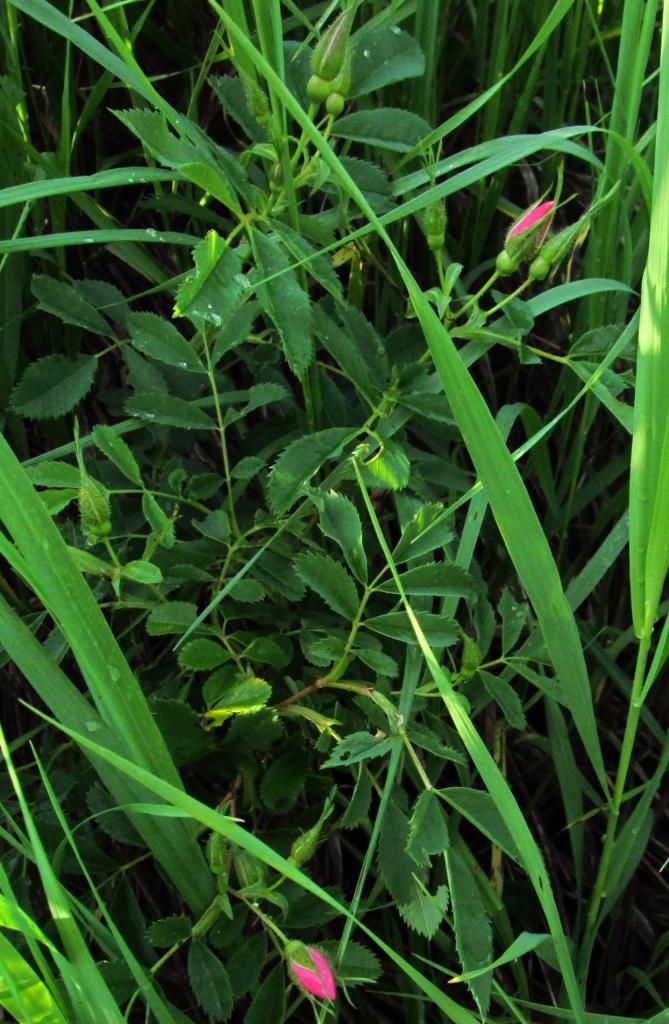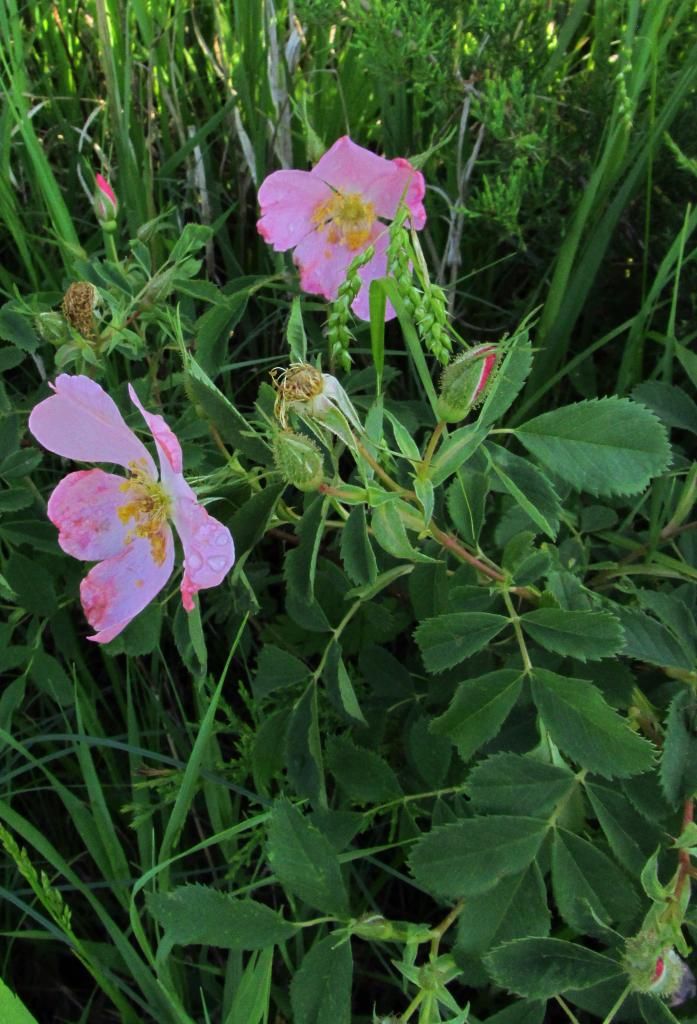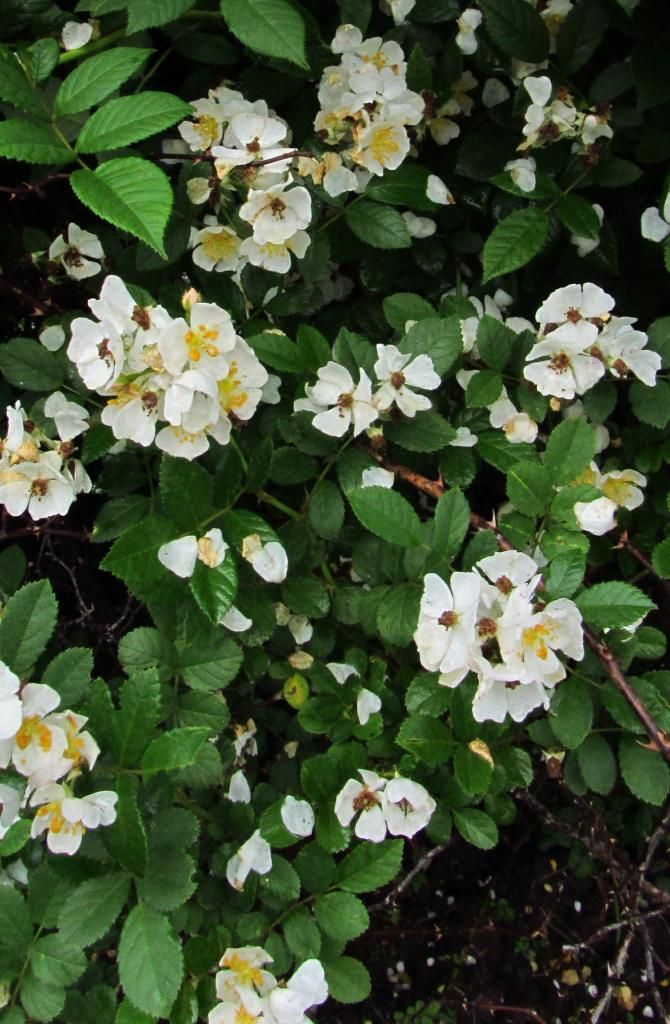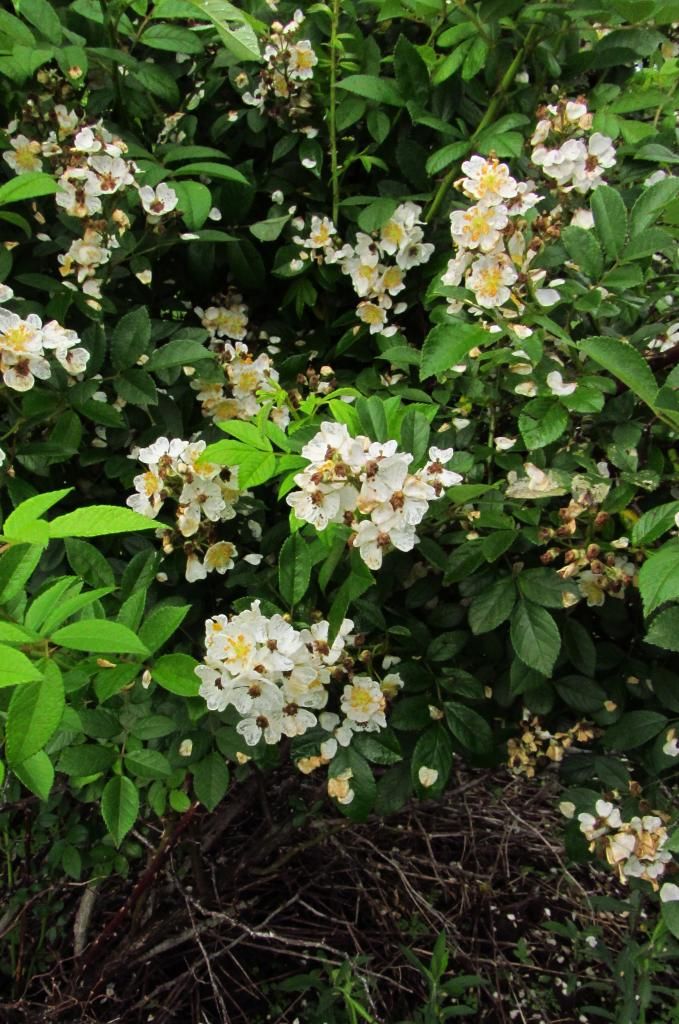Since I started Bleeding Heartland’s weekly wildflower series in 2012, I’ve planned to feature Iowa’s state flower, the wild rose. However, for whatever reason I never ran across this plant at the peak of its blooming period when I had my camera handy. This year I was determined to catch some wild rose blossoms, so a couple of weeks ago I headed down to the Stamps Family Farm near Chariton (Lucas County), having received a tip that roses were flowering. Fortunately for me, the rain let up just before I arrived.
After the jump I’ve enclosed photographs of native wild roses, along with a few pictures of multiflora roses. Rosa multiflora is considered an invasive species in much of North America, native to eastern Asia and brought here “as garden plants and as root stock for ornamental roses.” It’s on the noxious weed list of Iowa and several neighboring states and is a common sight out in the country.
This post is also a mid-week open thread: all topics welcome.
I don’t know the exact species depicted here. Chad Stamps and I found these wild roses blooming near a roadside. Danelle Stamps posted her own photos at her blog. According to Linda Naeve of Iowa State University’s Department of Horticulture,
Many settlers in Iowa admired the rose growing wild throughout the state. In 1896, the Iowa legislature selected it as the motif on a silver tea set presented to the U.S. Navy and used on the battleship Iowa. A year later, on May 6, 1897, with the advice of State Federation of Women’s Clubs in Dubuque, the legislature designated the “wild rose” as the state flower of Iowa.
Several wild rose species are native to Iowa. However, the legislature did not designate a specific wild rose species as our state symbol. Three “wild” roses native to Iowa can be considered our state flower: Rosa arkansana, Rosa blanda, and Rosa carolina. The individual species are difficult to tell apart because they are very similar in appearance and they hybridize easily and naturally.
Rosa blanda (meadow rose) is found in Iowa’s prairies, meadows, and open woodlands. This shrub-like plant will grow to four feet tall. It produces large showy pink flowers from June through late summer. The fruit, called “hips”, resemble small apples, and are about half-inch in diameter. Rosa blanda is most often given the honor of being the state flower, even though it is common only in the northern half of the state.
Rosa arkansana (Arkansas rose) is quite similar to R. blanda. It is a small shrub that grows in a wide range of soil conditions. This rose is found in prairies, meadows, and open woodlands. It grows up to 3 feet tall and blooms in June with masses of pink to dark pink, fragrant blossoms. The small, red, apple-shaped hips appear in late summer.
Rosa carolina is another wild rose species that can be seen blooming in meadows and woodlands throughout the state.
Wild rose plants can easily be overlooked when not blooming. This plant caught our attention only because of the dark pink buds, nearly ready to open.
The pink petals of wild rose flowers provide a sharp contrast to the yellow stamens. Sometimes the petals are deep pink, but more often I’ve seen pale pink blossoms like these. (The buds are a darker shade.)
According to Wildflowers of the Tallgrass Prairie by Sylvan Runkel and Dean Roosa,
This base [for the flower] matures into a smooth, red, apple-like fruit 1/2 inch in diameter. These fruits, or hips, maintain their color into winter.
The Meskawki and the Menomini boiled the hips to make a syrup for various nutritional uses. Skins of hips were used for stomach troubles. […]
Native Americans and pioneers ate the hips, flowers, leaves, and new shoots when other food was scarce. Rose hips are still an important wildlife food.
Three rose hips are said to contain as much vitamin C as an orange. Health food stores often sell rose hips.
On the Stamps Family Farm, Berkshire pigs are moved from pasture to pasture rather than raised in confinements like most Iowa hogs. Some massive multiflora rose bushes thrive in and around these pastures. Many grew to a height of six to ten feet. You can understand why some people have planted Rosa multiflora as wind breaks. They could create a thick barrier, and the rose hips can be harvested as with wild roses.
I wasn’t able to get any good shots of the whole multiflora bushes, but here are a few pictures of the white blossoms. Sometimes the petals look almost translucent.







4 Comments
Had a great time!
Looking forward to having you come out again some time. Thanks!
I do think 10 feet is pretty conservative – a few of the really big ones have got to be 15+!
One of my projects over the next year or two will be to cut/burn back a few of these, but I I do plan to keep a few and move oak seedlings underneath them as an experiment. I’ve found these protecting trees and that may be a great way to get oaks started in some of the paddocks we bring pigs through.
stampsc Wed 25 Jun 9:33 PM
Takeaways from the Mississippi repub runoff
Teapubs from the top on down are fuming over Thad Cochran’s appealing to the Black community for support (and apparently getting it) on Tuesday.
Gnashing of teeth over “Democrats influencing the results in Republican primaries” and the like.
And here I thought that within Repub circles the influencing of the other party’s primaries was legit and even honorable after the leader of the party, ol Rush himself beat the drum pretty loudly for Repubs to take part in the 2008 Demo primaries.
He called it Operation Chaos (that’s a GOOGLE-able term that’ll lead to several of Limbaugh’s own transcripts and even recorded vids) and his intent was to keep the Hillary and Obama people fighting with each other all spring and summer long.
I guess it’s OK for repubs but not for demos.
conservative-demo Thu 26 Jun 9:07 AM
no one broke any rules
from what I’ve read. Politics ain’t beanbag.
desmoinesdem Thu 26 Jun 10:36 AM
Multiflora
I’m afraid a lot of credit has to go to public agencies for bringing multiflora to the countryside. It was heavily promoted as a farm plant. I have written records for my land in which there is proof that a previous owner was advised by one agency to plant rows of multiflora rose as living livestock fences that would also be good for wildlife. As it turned out, of course, multiflora is horrible for pastures and not so great for wildlife either.
PrairieFan Thu 11 May 1:05 AM